Elara Case Study +
Training at the Tip of the Spear:
The Evolution of Alcon’s Digital Training Initiatives
This case study will focus on the efforts of Elara Systems, Inc. and Alcon to create a robust Virtual Reality training experience for eye care professionals. Elara Systems is a creative studio located in Sacramento, California specializing in 3D animation and XR development. Alcon is the global leader in eye care offering Surgical and Vision Care products that touch the lives of more than 260 million people in over 140 countries each year living with conditions like cataracts, glaucoma, retinal diseases, and refractive errors.
When Alcon’s quest to always be at the front of the pack in utilizing emergent technologies met with Elara’s drive for constant expansion of its capabilities, an evolutionary process occurred. In this study, we will observe the evolution of how Elara went from creating simple 3D models and animations for Alcon all the way to developing a robust Virtual Reality training and interactive product education and demonstration library.
Humble beginnings
Elara started working with Alcon in 2009 creating 3D animation highlighting the benefits and effectiveness of one of its contact lens solutions. The animation was a success and, in 2010, was followed by a project commissioned by Rustin Floyd, who is currently the Global Director, Head of Healthcare Professional Training and Education at Alcon.
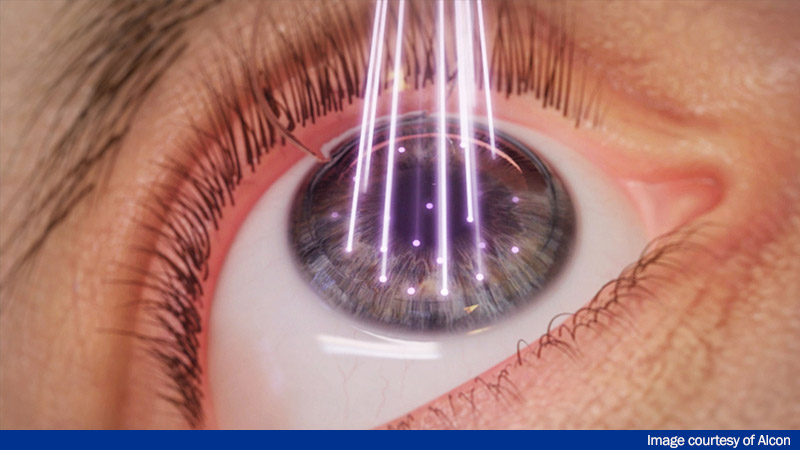
Rustin wanted Elara to create a 3D animation highlighting the benefits of the Alcon WaveLight® Refractive Suite (a collection of equipment for use in laser vision correction). One thing that stood out for Rustin was the fact that the people he showed the animation to actually thought it was a video due to the photorealistic quality of the piece. This inspired Alcon and Elara to ideate around creating even more compelling visual content.
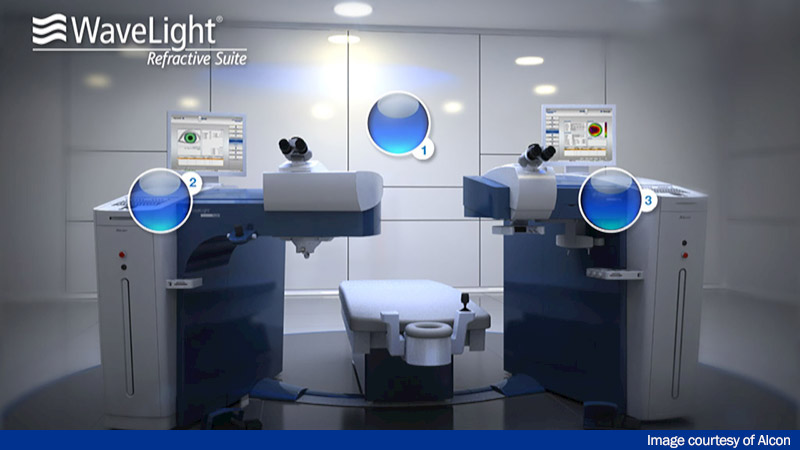
Rustin is a proponent of emergent technology and several years after the WaveLight project, he reached out to Elara to create a Virtual Reality (VR) piece that would take a viewer inside of the eye to see anatomy and physiology that cannot be seen without an invasive procedure. The resultant project was the Alcon Virtual Eye Experience.
As Rustin notes, “It’s one thing to teach about the eye and how it works…it’s another thing to stand inside the eye and teach how it works.” The challenge of the Virtual Eye Experience was to engage and educate eye care professionals in a compelling way, unique to ophthalmology.
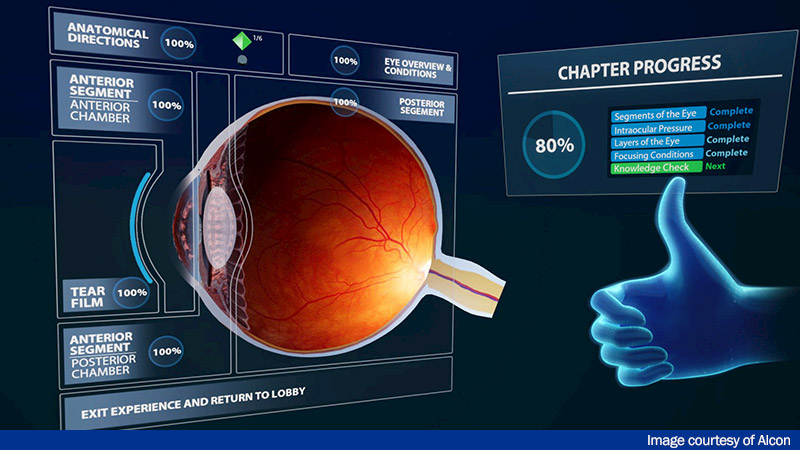
Going Live
After approximately four months of development, the Alcon Virtual Eye Experience was ready to show at the annual congress of the American Association of Ophthalmology (AAO) held in New Orleans in late-2017. AAO is a worldwide gathering of ophthalmologists and companies which provide medical devices, equipment, and support for the industry. Needless to say, this event was a very big deal for Elara and for Alcon.
The primary purpose behind debuting VR at AAO was to attract ophthalmologists and other potential customers to Alcon’s booth, to showcase Alcon’s commitment to training and education through the novel approach of Virtual Reality – a technology, new to the ophthalmic space. Alcon designed free-standing VR kiosks where multiple VR headsets were stationed so that attendees could view the Virtual Eye Experience.
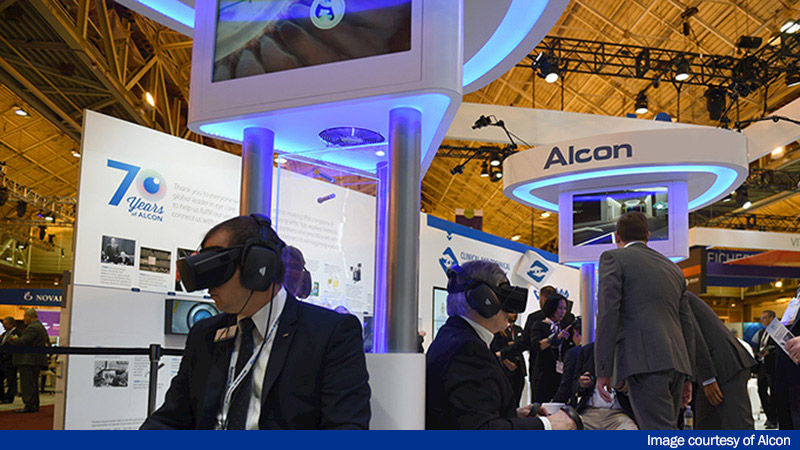
The Alcon booth was well-received, with lines of attendees queued up to view the Virtual Eye Experience. As the tradeshow progressed and more physicians were journeying through the eye, there was a realization that while the Virtual Eye Experience was captivating, the functionality of the experience could be even better. Specifically, there was an opportunity to help facilitate users’ engagement with the interactions while in the experience, bringing interactive elements directly to their hand controllers. Throughout the tradeshow, Rustin and Elara were diligently collecting feedback and then conceptualizing ways to improve the experience, ultimately making it more impactful and engaging for their customers.
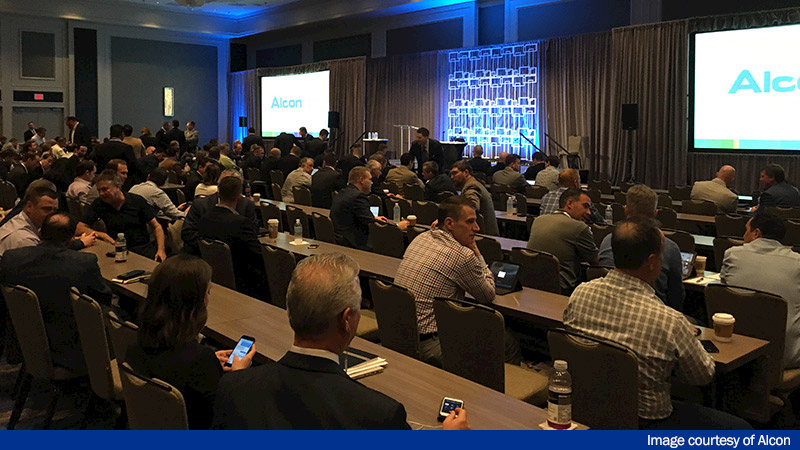
The success of the Virtual Eye Experience opened the doors to further VR development at Alcon, and the company was looking beyond a simple splash at a trade show. Working collaboratively, Elara and Alcon came up with numerous other applications for the technology.
Leveraging content: other uses of VR and 3D assets
On the Vision Care side of Alcon’s business, Tyler Snyder, the Global Director of Commercial Development in Alcon’s Vision Care Franchise knew that his sales team, and the optometrists they visited, were weary of going through PowerPoint presentations on an iPad to go over new products and technologies. To enhance the sales experience, Tyler launched a fleet of Oculus Go’s to his sales team so that they could put their customers into VR to view experiences featuring Alcon’s products. The roll-out of this program was met with enthusiasm from his sales team and the optometrists who viewed the presentations.
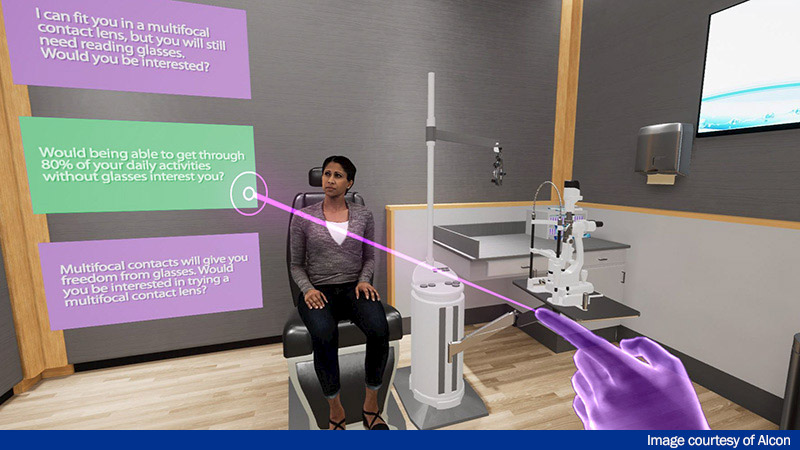
More recently, during the COVID pandemic, Alcon transformed their trade shows onto virtual, web-based platforms. Utilizing 3D models taken from a VR product presentation was placed into a web-accessible 3D operating room environment. Attendees could view the equipment from their computers or tablets and move around the virtual 3D space using their mouse pad. Additionally, they could be joined by Alcon sales representatives using a web-based real-time communication platform similar to Zoom or Microsoft Teams. The Alcon representative could go over the product’s features and benefits and also provide training tips on how to utilize the devices.
Alcon’s willingness to explore new methods of communication and engagement is summed up quite succinctly by Rustin, “One of the challenges of a medical device company is finding technology to educate our health care professionals in a way that is as sophisticated, and as engaging, as the medical devices themselves.”
As the depth and breadth of Alcon’s digital education library continued to expand, it became clear to Elara and Alcon that reusing previously created models and environments created efficiencies that drove down price and development time. This allowed for the production of more innovative VR applications while keeping prices within reason. This allowed for even more innovation into immersive training.
Let’s start training
Elara and Alcon realized that the immersive nature of VR made it ideal for learning and training. As Rustin points out, “There is no other training and education medium, outside of hands-on experience, which immerses and engages the audience like virtual reality does. There are no distractions, no multi-tasking, the viewer is completely enveloped in the learning environment.”
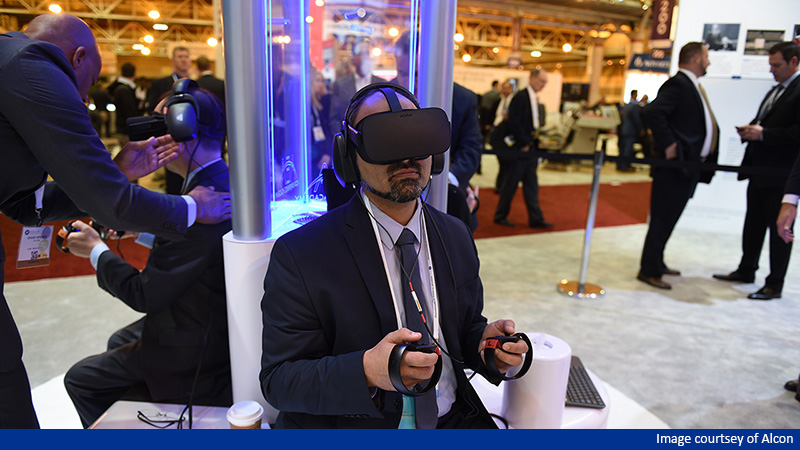
Early on, Elara developed an eye anatomy and physiology trainer to help Alcon associates learn more about the eye itself. Elara was able to incorporate 3D models developed for use in the Virtual Eye Experience and employ them in the training application. This helped reduce cost and production time because the entire experience was not built from scratch.
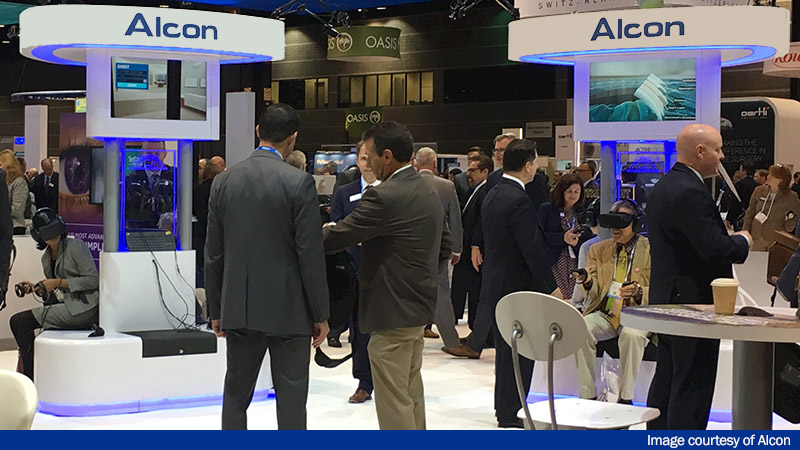
On a regular basis, new Alcon products continued to be featured in VR experiences at trade shows. However, there was a continued ask from ophthalmologists: They wanted more content relating to surgical training in VR. At the next AAO annual congress in Chicago, in 2018, Alcon had multiple VR kiosks featuring surgical case studies – filmed in 360-degree video – that could be viewed by surgeons. Many surgeons spent exceedingly long periods of time watching the surgeries.
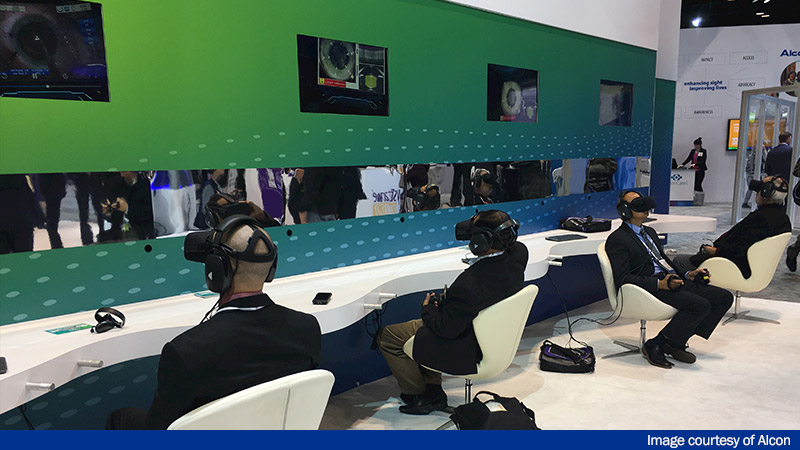
Based on the level of interest among surgeons for more surgical training, Alcon commissioned the creation of the Virtual Surgical Site Visit. In order to create this experience, the Elara team and a 360-degree video crew went to a leading eye institute. They filmed multiple surgeries performed by a leading U.S. ophthalmologist. In addition to being able to be virtually inside the operating room, viewers could watch the surgery from multiple angles and on multiple display screens while learning key insights from the case studies.
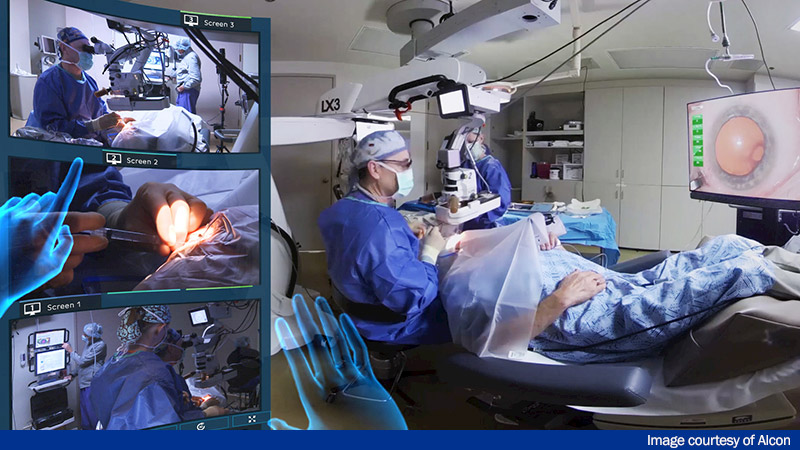
Despite the success of the surgical training experiences, there was one persistent ask from all of the surgeons: They wanted to be able to practice surgery in VR. They also wanted the force-feedback enabled by haptic technology so that they could hold a device in their hand and feel as if they were actually performing a real cataract surgery. It’s quite possible that surgical simulation could be the next frontier explored by Alcon and Elara.
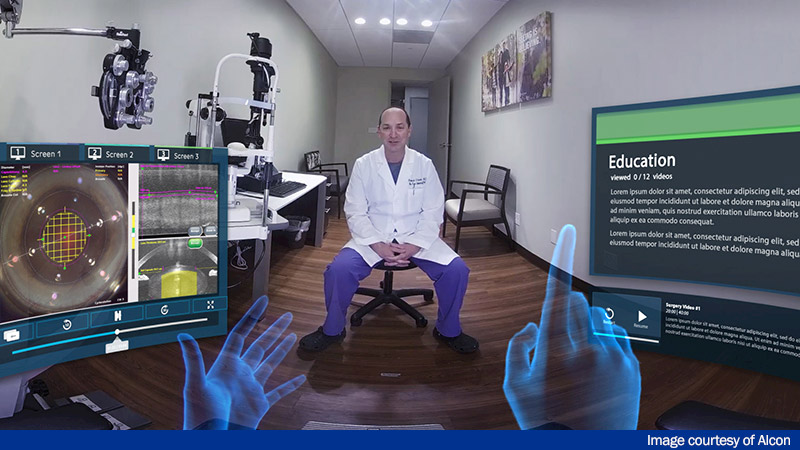
Conclusion
The relationship that exists between Elara and Alcon is not necessarily unique, but it requires several key elements in order to evolve. First, the ability to collaborate is essential. The free-flowing exchange of ideas and feedback between the two teams is fundamental to success. Both parties need to be able to talk to each other without reservation, allowing the best ideas to rise to the surface.
Leveraging analytics to measure success was the key element of evolutionary growth driving future projects. KPIs throughout the projects continued to evolve – from collecting data on the amount of time spent in VR to the total the impressions gathered from the viewers. The more complex the project gets, the more advanced the KPIs.
Lastly, a key part of Elara and Alcon’s collective success in VR was dependent on having strong and determined internal advocates within the organization. It is important to have tech-forward advocates, like Rustin Floyd and Tyler Snyder at Alcon, to help drive VR initiatives.
Looking back on the journey with Rustin and Elara, Rustin states, “By allowing our customers to experience Alcon’s innovative technology – whether in person at one of our Alcon Experience Centers or virtually through our VR technology – this can help eye care professionals have more confidence in our products while helping us deliver on our mission of helping people See Brilliantly.”
